Identifying Resilience Toolkits for New Nurses in Healthcare Setting
VerifiedAdded on 2022/12/05
|8
|1982
|373
Essay
AI Summary
This essay identifies and discusses the importance of a personal resilience toolkit for newly qualified nurses transitioning into their initial role as Registered Nurses. It highlights the challenges faced by new nurses, including the gap between academic experience and clinical practice, demanding work environments, time constraints, and the need for effective stress management. The essay explores the concept of a resilience toolkit, emphasizing its role in reducing tension, building resilience, and fostering meaningful change. It examines various stressors faced by nurses, such as job overload, interpersonal issues, and organizational pressures, as well as the negative consequences of stress, including burnout and reduced quality of care. The essay discusses the Stress Management and Resiliency Training (SMART) program as a potential intervention and suggests strategies for cultivating resilience, such as mindfulness and self-awareness. The essay also addresses the need for support and resources to enhance nurses' ability to cope with workplace challenges and improve retention rates. The provided solution is a student essay discussing the importance of resilience toolkits for new nurses, along with references.

Identify and discuss the importance of
a personal resilience toolkit for newly
qualified nurses when transitioning to
their initial role as a Registered Nurse
a personal resilience toolkit for newly
qualified nurses when transitioning to
their initial role as a Registered Nurse
Paraphrase This Document
Need a fresh take? Get an instant paraphrase of this document with our AI Paraphraser
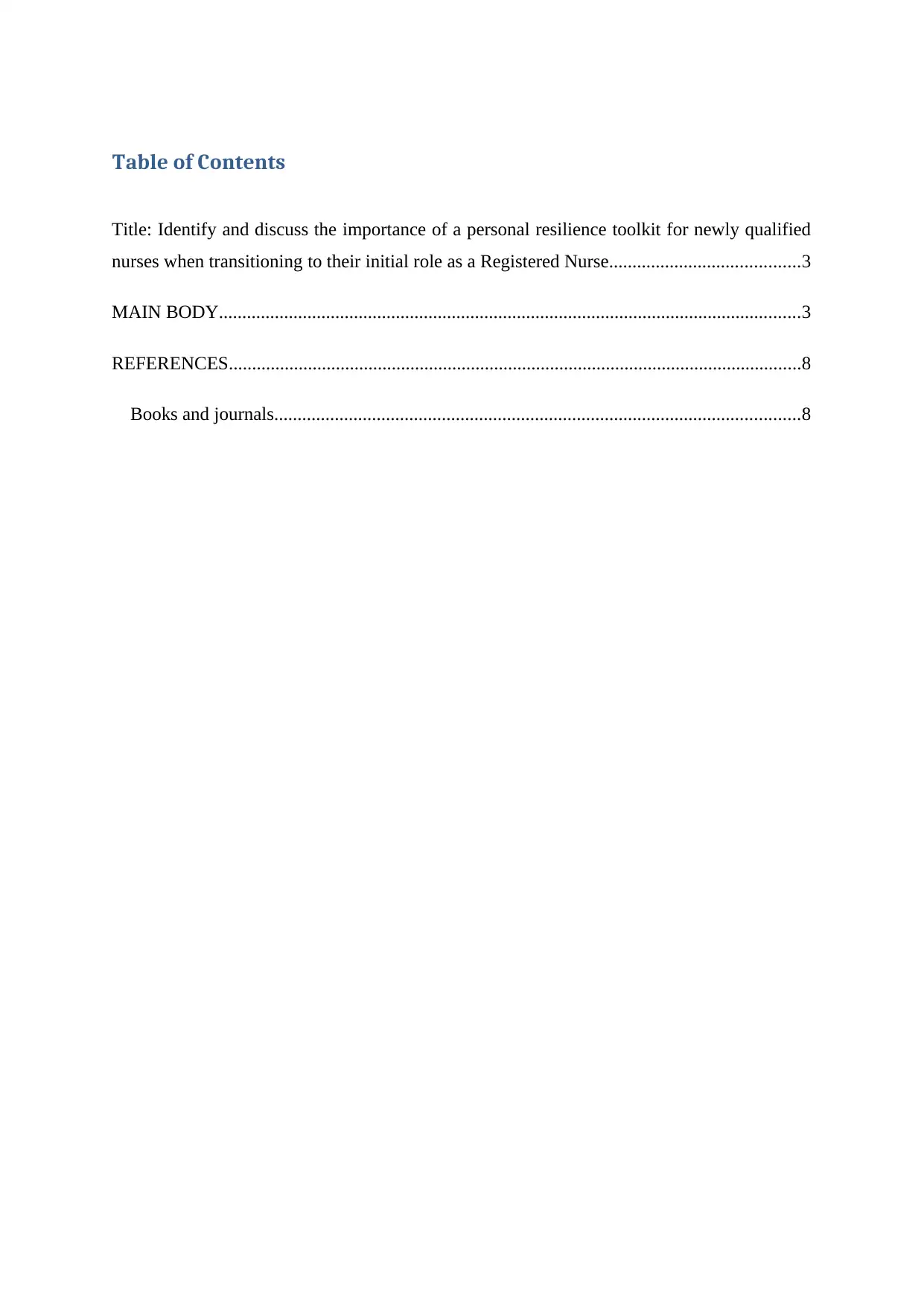
Table of Contents
Title: Identify and discuss the importance of a personal resilience toolkit for newly qualified
nurses when transitioning to their initial role as a Registered Nurse.........................................3
MAIN BODY.............................................................................................................................3
REFERENCES...........................................................................................................................8
Books and journals.................................................................................................................8
Title: Identify and discuss the importance of a personal resilience toolkit for newly qualified
nurses when transitioning to their initial role as a Registered Nurse.........................................3
MAIN BODY.............................................................................................................................3
REFERENCES...........................................................................................................................8
Books and journals.................................................................................................................8
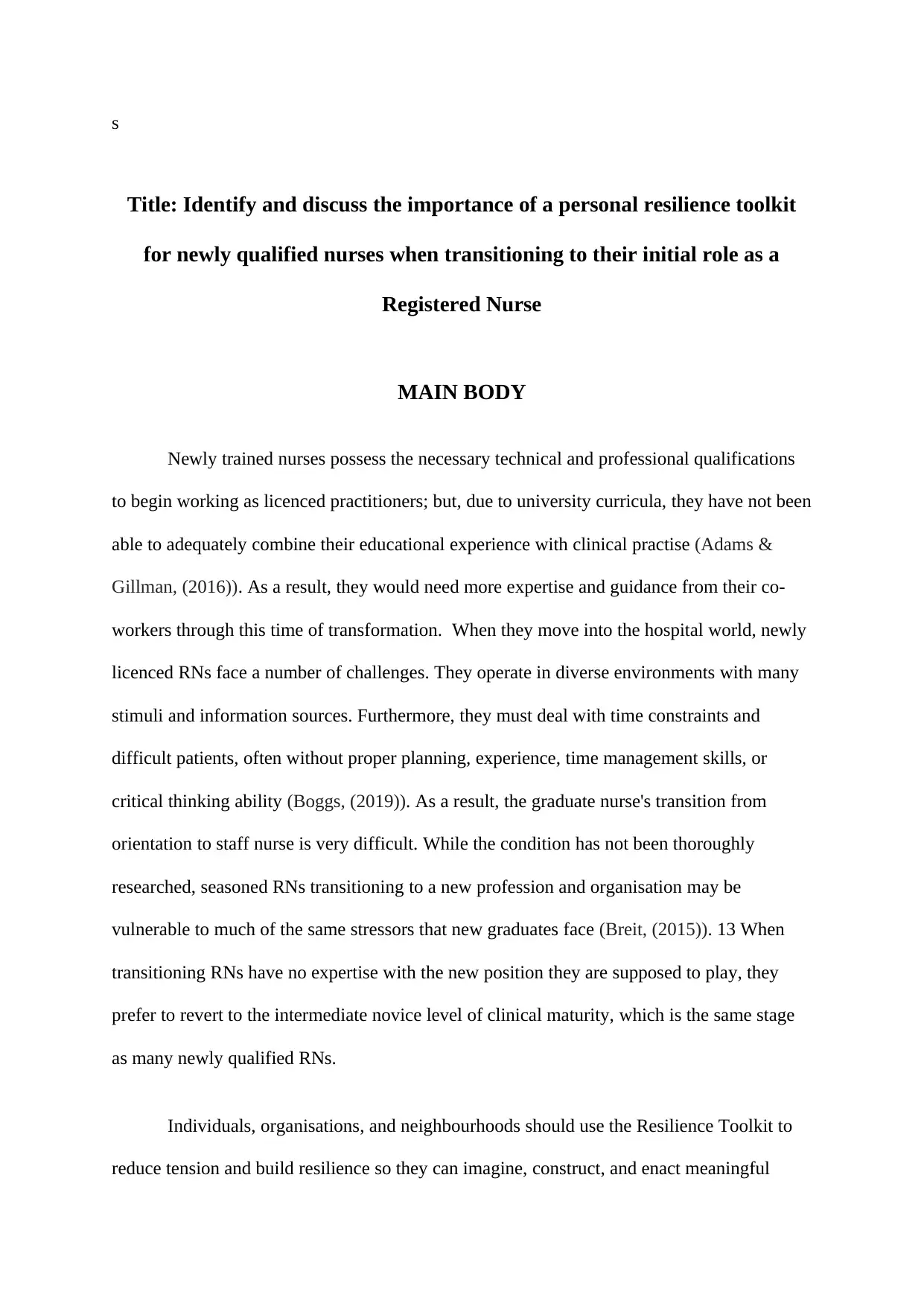
s
Title: Identify and discuss the importance of a personal resilience toolkit
for newly qualified nurses when transitioning to their initial role as a
Registered Nurse
MAIN BODY
Newly trained nurses possess the necessary technical and professional qualifications
to begin working as licenced practitioners; but, due to university curricula, they have not been
able to adequately combine their educational experience with clinical practise (Adams &
Gillman, (2016)). As a result, they would need more expertise and guidance from their co-
workers through this time of transformation. When they move into the hospital world, newly
licenced RNs face a number of challenges. They operate in diverse environments with many
stimuli and information sources. Furthermore, they must deal with time constraints and
difficult patients, often without proper planning, experience, time management skills, or
critical thinking ability (Boggs, (2019)). As a result, the graduate nurse's transition from
orientation to staff nurse is very difficult. While the condition has not been thoroughly
researched, seasoned RNs transitioning to a new profession and organisation may be
vulnerable to much of the same stressors that new graduates face (Breit, (2015)). 13 When
transitioning RNs have no expertise with the new position they are supposed to play, they
prefer to revert to the intermediate novice level of clinical maturity, which is the same stage
as many newly qualified RNs.
Individuals, organisations, and neighbourhoods should use the Resilience Toolkit to
reduce tension and build resilience so they can imagine, construct, and enact meaningful
Title: Identify and discuss the importance of a personal resilience toolkit
for newly qualified nurses when transitioning to their initial role as a
Registered Nurse
MAIN BODY
Newly trained nurses possess the necessary technical and professional qualifications
to begin working as licenced practitioners; but, due to university curricula, they have not been
able to adequately combine their educational experience with clinical practise (Adams &
Gillman, (2016)). As a result, they would need more expertise and guidance from their co-
workers through this time of transformation. When they move into the hospital world, newly
licenced RNs face a number of challenges. They operate in diverse environments with many
stimuli and information sources. Furthermore, they must deal with time constraints and
difficult patients, often without proper planning, experience, time management skills, or
critical thinking ability (Boggs, (2019)). As a result, the graduate nurse's transition from
orientation to staff nurse is very difficult. While the condition has not been thoroughly
researched, seasoned RNs transitioning to a new profession and organisation may be
vulnerable to much of the same stressors that new graduates face (Breit, (2015)). 13 When
transitioning RNs have no expertise with the new position they are supposed to play, they
prefer to revert to the intermediate novice level of clinical maturity, which is the same stage
as many newly qualified RNs.
Individuals, organisations, and neighbourhoods should use the Resilience Toolkit to
reduce tension and build resilience so they can imagine, construct, and enact meaningful
⊘ This is a preview!⊘
Do you want full access?
Subscribe today to unlock all pages.

Trusted by 1+ million students worldwide
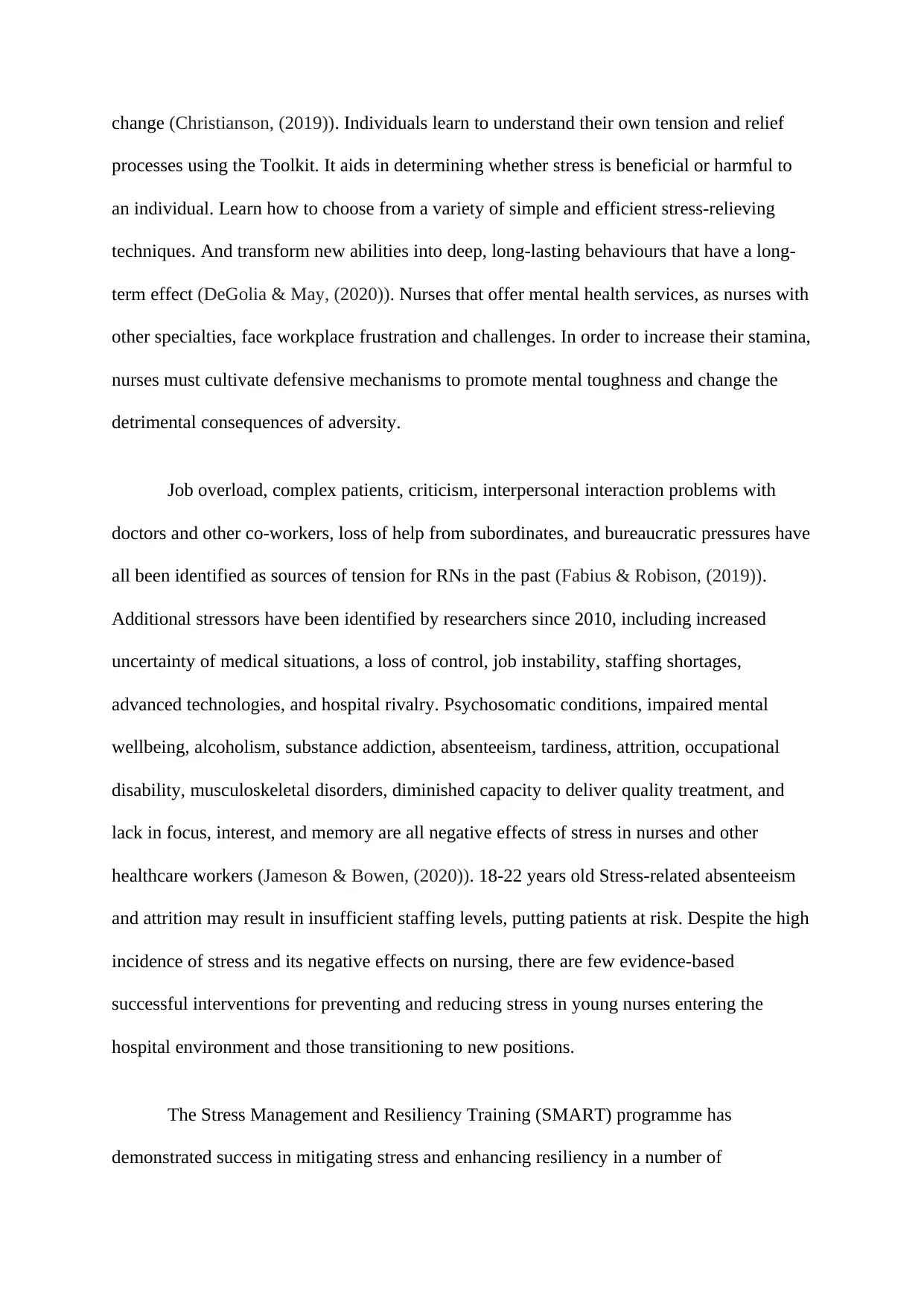
change (Christianson, (2019)). Individuals learn to understand their own tension and relief
processes using the Toolkit. It aids in determining whether stress is beneficial or harmful to
an individual. Learn how to choose from a variety of simple and efficient stress-relieving
techniques. And transform new abilities into deep, long-lasting behaviours that have a long-
term effect (DeGolia & May, (2020)). Nurses that offer mental health services, as nurses with
other specialties, face workplace frustration and challenges. In order to increase their stamina,
nurses must cultivate defensive mechanisms to promote mental toughness and change the
detrimental consequences of adversity.
Job overload, complex patients, criticism, interpersonal interaction problems with
doctors and other co-workers, loss of help from subordinates, and bureaucratic pressures have
all been identified as sources of tension for RNs in the past (Fabius & Robison, (2019)).
Additional stressors have been identified by researchers since 2010, including increased
uncertainty of medical situations, a loss of control, job instability, staffing shortages,
advanced technologies, and hospital rivalry. Psychosomatic conditions, impaired mental
wellbeing, alcoholism, substance addiction, absenteeism, tardiness, attrition, occupational
disability, musculoskeletal disorders, diminished capacity to deliver quality treatment, and
lack in focus, interest, and memory are all negative effects of stress in nurses and other
healthcare workers (Jameson & Bowen, (2020)). 18-22 years old Stress-related absenteeism
and attrition may result in insufficient staffing levels, putting patients at risk. Despite the high
incidence of stress and its negative effects on nursing, there are few evidence-based
successful interventions for preventing and reducing stress in young nurses entering the
hospital environment and those transitioning to new positions.
The Stress Management and Resiliency Training (SMART) programme has
demonstrated success in mitigating stress and enhancing resiliency in a number of
processes using the Toolkit. It aids in determining whether stress is beneficial or harmful to
an individual. Learn how to choose from a variety of simple and efficient stress-relieving
techniques. And transform new abilities into deep, long-lasting behaviours that have a long-
term effect (DeGolia & May, (2020)). Nurses that offer mental health services, as nurses with
other specialties, face workplace frustration and challenges. In order to increase their stamina,
nurses must cultivate defensive mechanisms to promote mental toughness and change the
detrimental consequences of adversity.
Job overload, complex patients, criticism, interpersonal interaction problems with
doctors and other co-workers, loss of help from subordinates, and bureaucratic pressures have
all been identified as sources of tension for RNs in the past (Fabius & Robison, (2019)).
Additional stressors have been identified by researchers since 2010, including increased
uncertainty of medical situations, a loss of control, job instability, staffing shortages,
advanced technologies, and hospital rivalry. Psychosomatic conditions, impaired mental
wellbeing, alcoholism, substance addiction, absenteeism, tardiness, attrition, occupational
disability, musculoskeletal disorders, diminished capacity to deliver quality treatment, and
lack in focus, interest, and memory are all negative effects of stress in nurses and other
healthcare workers (Jameson & Bowen, (2020)). 18-22 years old Stress-related absenteeism
and attrition may result in insufficient staffing levels, putting patients at risk. Despite the high
incidence of stress and its negative effects on nursing, there are few evidence-based
successful interventions for preventing and reducing stress in young nurses entering the
hospital environment and those transitioning to new positions.
The Stress Management and Resiliency Training (SMART) programme has
demonstrated success in mitigating stress and enhancing resiliency in a number of
Paraphrase This Document
Need a fresh take? Get an instant paraphrase of this document with our AI Paraphraser
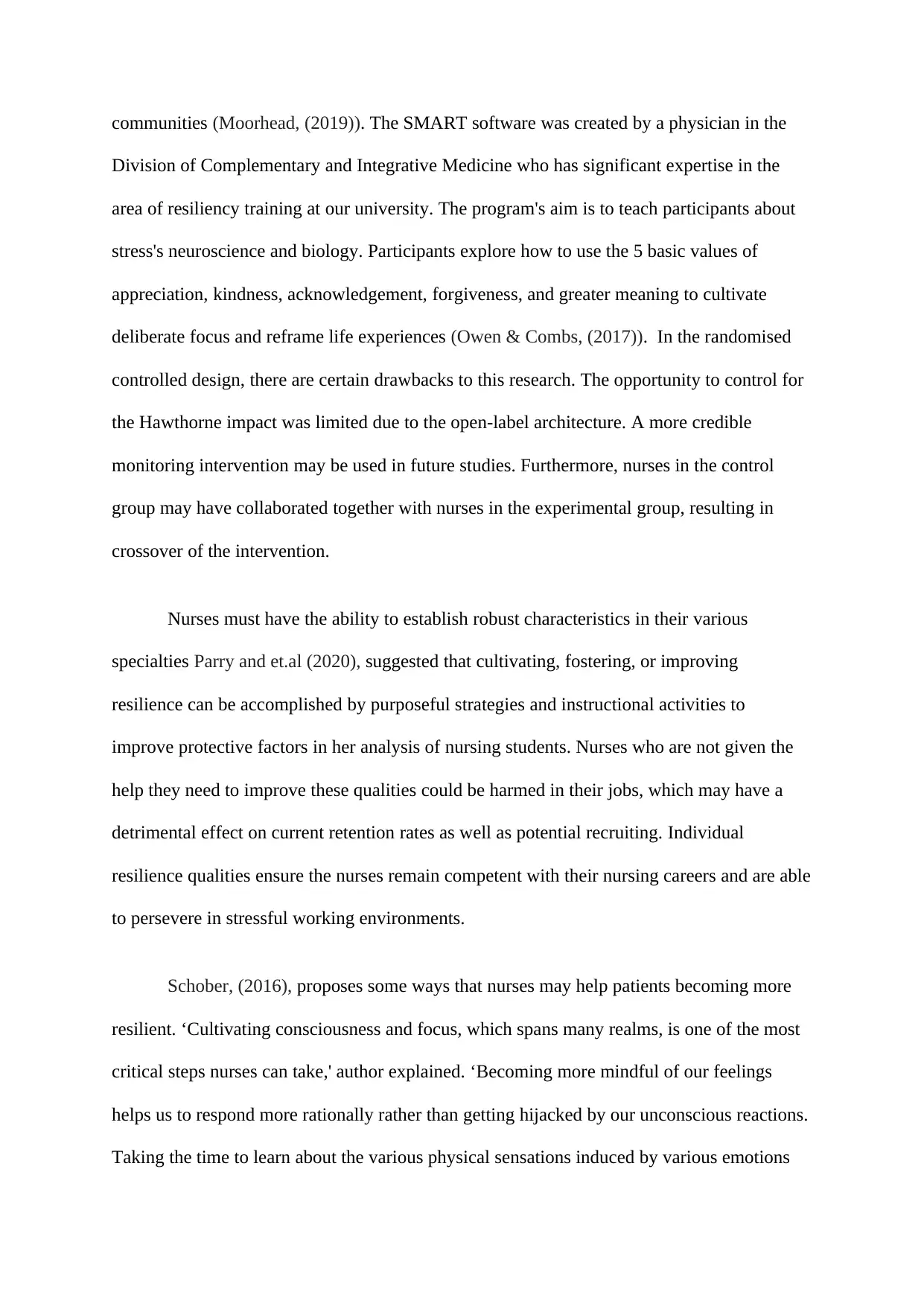
communities (Moorhead, (2019)). The SMART software was created by a physician in the
Division of Complementary and Integrative Medicine who has significant expertise in the
area of resiliency training at our university. The program's aim is to teach participants about
stress's neuroscience and biology. Participants explore how to use the 5 basic values of
appreciation, kindness, acknowledgement, forgiveness, and greater meaning to cultivate
deliberate focus and reframe life experiences (Owen & Combs, (2017)). In the randomised
controlled design, there are certain drawbacks to this research. The opportunity to control for
the Hawthorne impact was limited due to the open-label architecture. A more credible
monitoring intervention may be used in future studies. Furthermore, nurses in the control
group may have collaborated together with nurses in the experimental group, resulting in
crossover of the intervention.
Nurses must have the ability to establish robust characteristics in their various
specialties Parry and et.al (2020), suggested that cultivating, fostering, or improving
resilience can be accomplished by purposeful strategies and instructional activities to
improve protective factors in her analysis of nursing students. Nurses who are not given the
help they need to improve these qualities could be harmed in their jobs, which may have a
detrimental effect on current retention rates as well as potential recruiting. Individual
resilience qualities ensure the nurses remain competent with their nursing careers and are able
to persevere in stressful working environments.
Schober, (2016), proposes some ways that nurses may help patients becoming more
resilient. ‘Cultivating consciousness and focus, which spans many realms, is one of the most
critical steps nurses can take,' author explained. ‘Becoming more mindful of our feelings
helps us to respond more rationally rather than getting hijacked by our unconscious reactions.
Taking the time to learn about the various physical sensations induced by various emotions
Division of Complementary and Integrative Medicine who has significant expertise in the
area of resiliency training at our university. The program's aim is to teach participants about
stress's neuroscience and biology. Participants explore how to use the 5 basic values of
appreciation, kindness, acknowledgement, forgiveness, and greater meaning to cultivate
deliberate focus and reframe life experiences (Owen & Combs, (2017)). In the randomised
controlled design, there are certain drawbacks to this research. The opportunity to control for
the Hawthorne impact was limited due to the open-label architecture. A more credible
monitoring intervention may be used in future studies. Furthermore, nurses in the control
group may have collaborated together with nurses in the experimental group, resulting in
crossover of the intervention.
Nurses must have the ability to establish robust characteristics in their various
specialties Parry and et.al (2020), suggested that cultivating, fostering, or improving
resilience can be accomplished by purposeful strategies and instructional activities to
improve protective factors in her analysis of nursing students. Nurses who are not given the
help they need to improve these qualities could be harmed in their jobs, which may have a
detrimental effect on current retention rates as well as potential recruiting. Individual
resilience qualities ensure the nurses remain competent with their nursing careers and are able
to persevere in stressful working environments.
Schober, (2016), proposes some ways that nurses may help patients becoming more
resilient. ‘Cultivating consciousness and focus, which spans many realms, is one of the most
critical steps nurses can take,' author explained. ‘Becoming more mindful of our feelings
helps us to respond more rationally rather than getting hijacked by our unconscious reactions.
Taking the time to learn about the various physical sensations induced by various emotions
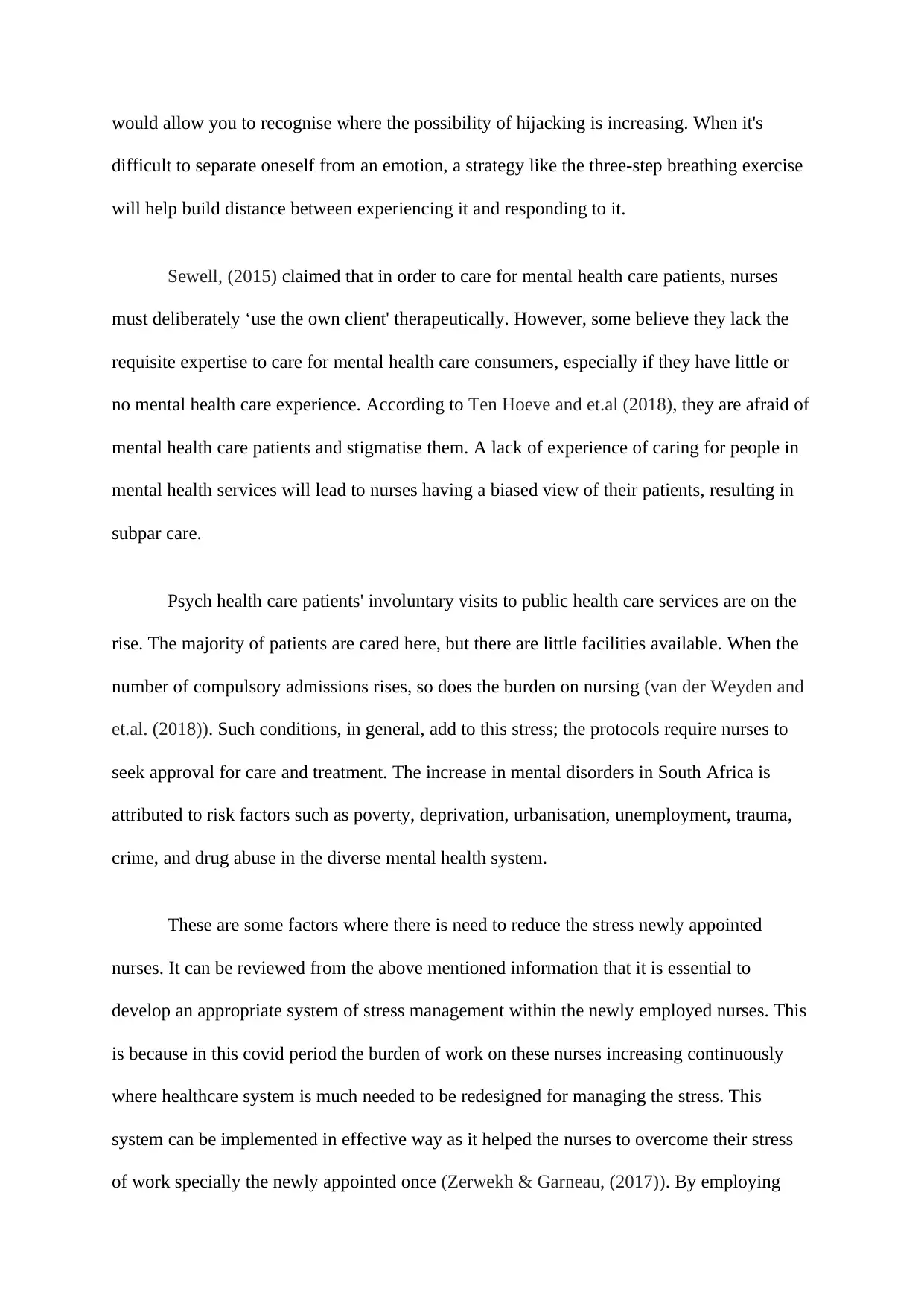
would allow you to recognise where the possibility of hijacking is increasing. When it's
difficult to separate oneself from an emotion, a strategy like the three-step breathing exercise
will help build distance between experiencing it and responding to it.
Sewell, (2015) claimed that in order to care for mental health care patients, nurses
must deliberately ‘use the own client' therapeutically. However, some believe they lack the
requisite expertise to care for mental health care consumers, especially if they have little or
no mental health care experience. According to Ten Hoeve and et.al (2018), they are afraid of
mental health care patients and stigmatise them. A lack of experience of caring for people in
mental health services will lead to nurses having a biased view of their patients, resulting in
subpar care.
Psych health care patients' involuntary visits to public health care services are on the
rise. The majority of patients are cared here, but there are little facilities available. When the
number of compulsory admissions rises, so does the burden on nursing (van der Weyden and
et.al. (2018)). Such conditions, in general, add to this stress; the protocols require nurses to
seek approval for care and treatment. The increase in mental disorders in South Africa is
attributed to risk factors such as poverty, deprivation, urbanisation, unemployment, trauma,
crime, and drug abuse in the diverse mental health system.
These are some factors where there is need to reduce the stress newly appointed
nurses. It can be reviewed from the above mentioned information that it is essential to
develop an appropriate system of stress management within the newly employed nurses. This
is because in this covid period the burden of work on these nurses increasing continuously
where healthcare system is much needed to be redesigned for managing the stress. This
system can be implemented in effective way as it helped the nurses to overcome their stress
of work specially the newly appointed once (Zerwekh & Garneau, (2017)). By employing
difficult to separate oneself from an emotion, a strategy like the three-step breathing exercise
will help build distance between experiencing it and responding to it.
Sewell, (2015) claimed that in order to care for mental health care patients, nurses
must deliberately ‘use the own client' therapeutically. However, some believe they lack the
requisite expertise to care for mental health care consumers, especially if they have little or
no mental health care experience. According to Ten Hoeve and et.al (2018), they are afraid of
mental health care patients and stigmatise them. A lack of experience of caring for people in
mental health services will lead to nurses having a biased view of their patients, resulting in
subpar care.
Psych health care patients' involuntary visits to public health care services are on the
rise. The majority of patients are cared here, but there are little facilities available. When the
number of compulsory admissions rises, so does the burden on nursing (van der Weyden and
et.al. (2018)). Such conditions, in general, add to this stress; the protocols require nurses to
seek approval for care and treatment. The increase in mental disorders in South Africa is
attributed to risk factors such as poverty, deprivation, urbanisation, unemployment, trauma,
crime, and drug abuse in the diverse mental health system.
These are some factors where there is need to reduce the stress newly appointed
nurses. It can be reviewed from the above mentioned information that it is essential to
develop an appropriate system of stress management within the newly employed nurses. This
is because in this covid period the burden of work on these nurses increasing continuously
where healthcare system is much needed to be redesigned for managing the stress. This
system can be implemented in effective way as it helped the nurses to overcome their stress
of work specially the newly appointed once (Zerwekh & Garneau, (2017)). By employing
⊘ This is a preview!⊘
Do you want full access?
Subscribe today to unlock all pages.

Trusted by 1+ million students worldwide
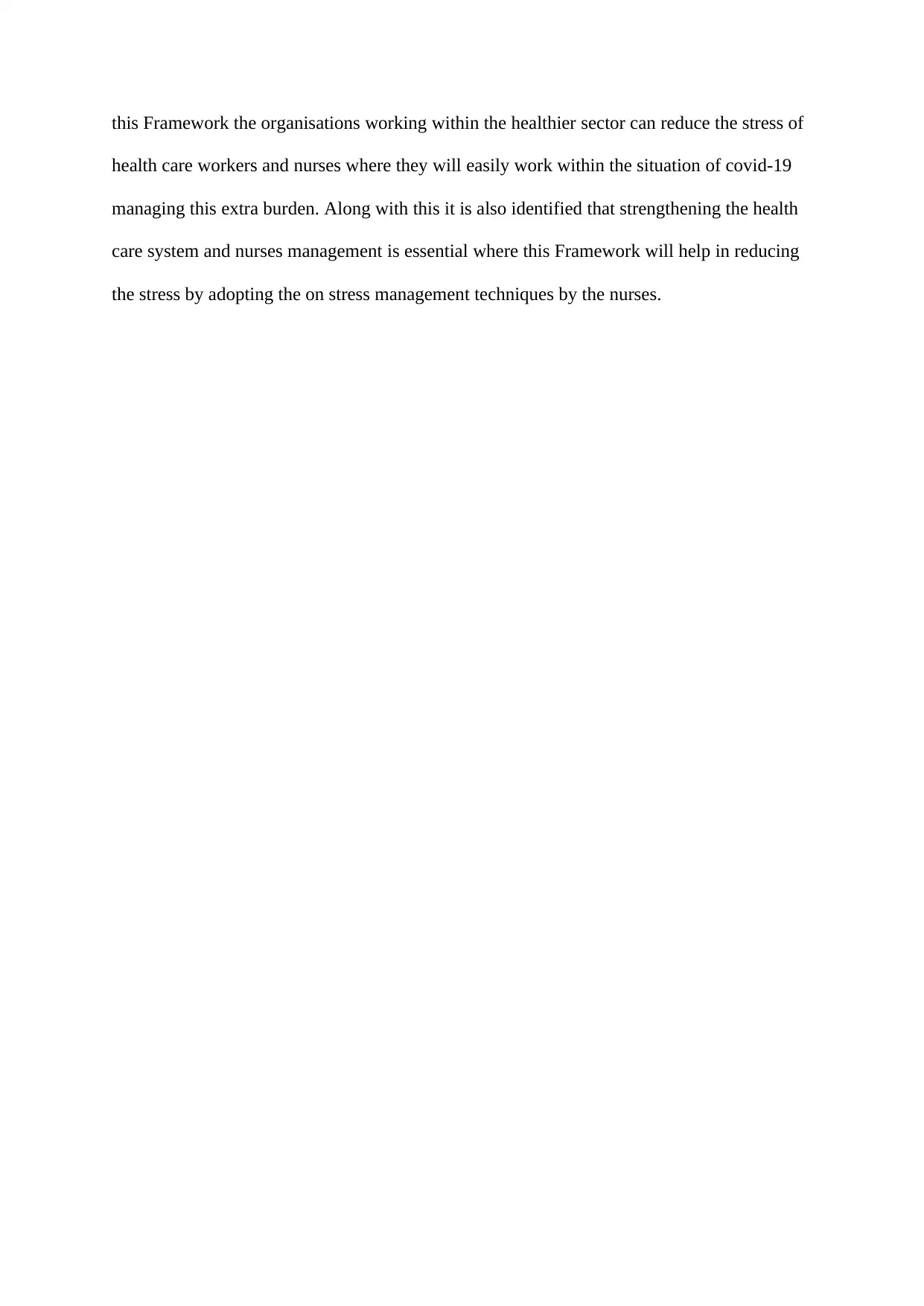
this Framework the organisations working within the healthier sector can reduce the stress of
health care workers and nurses where they will easily work within the situation of covid-19
managing this extra burden. Along with this it is also identified that strengthening the health
care system and nurses management is essential where this Framework will help in reducing
the stress by adopting the on stress management techniques by the nurses.
health care workers and nurses where they will easily work within the situation of covid-19
managing this extra burden. Along with this it is also identified that strengthening the health
care system and nurses management is essential where this Framework will help in reducing
the stress by adopting the on stress management techniques by the nurses.
Paraphrase This Document
Need a fresh take? Get an instant paraphrase of this document with our AI Paraphraser
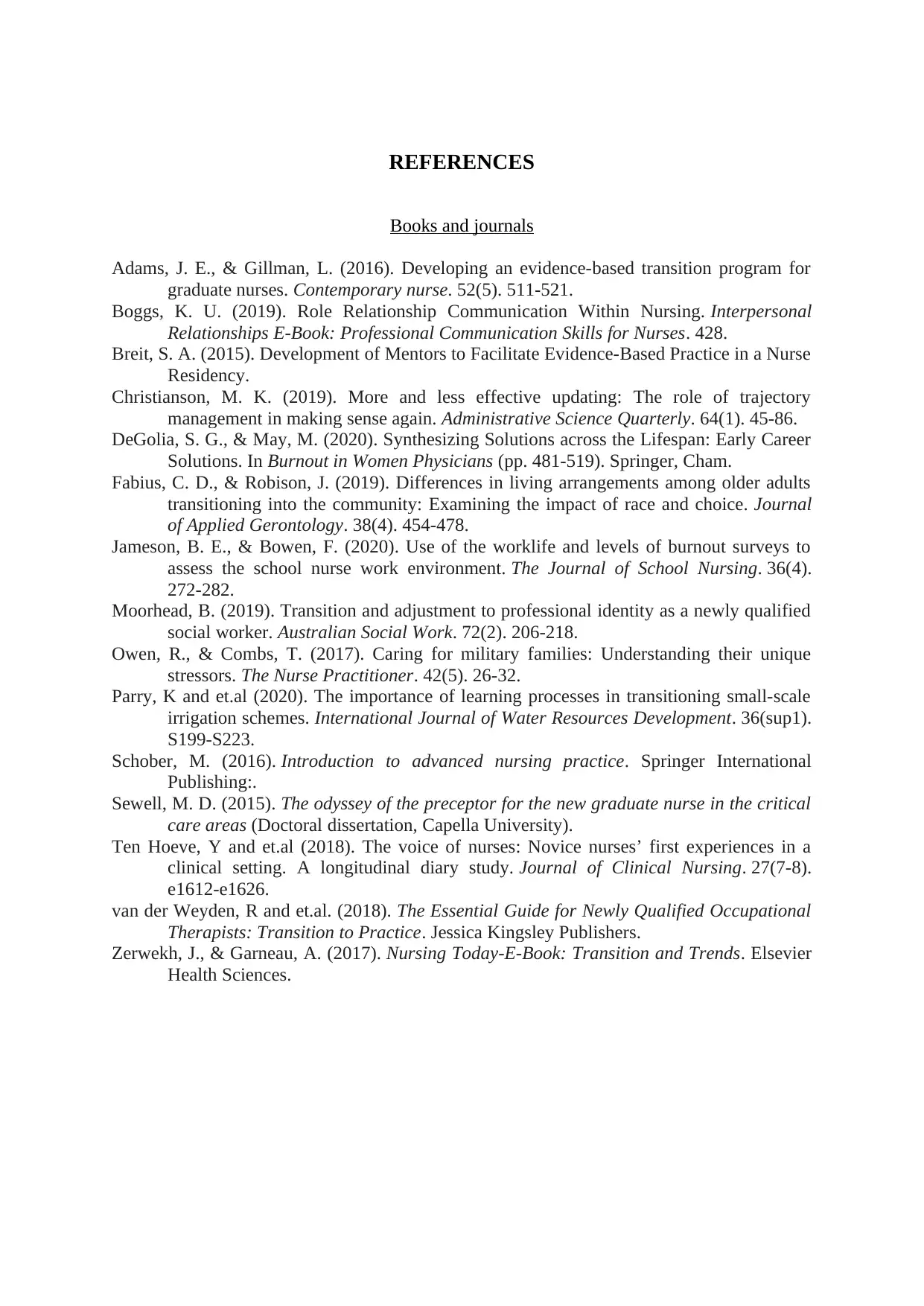
REFERENCES
Books and journals
Adams, J. E., & Gillman, L. (2016). Developing an evidence-based transition program for
graduate nurses. Contemporary nurse. 52(5). 511-521.
Boggs, K. U. (2019). Role Relationship Communication Within Nursing. Interpersonal
Relationships E-Book: Professional Communication Skills for Nurses. 428.
Breit, S. A. (2015). Development of Mentors to Facilitate Evidence-Based Practice in a Nurse
Residency.
Christianson, M. K. (2019). More and less effective updating: The role of trajectory
management in making sense again. Administrative Science Quarterly. 64(1). 45-86.
DeGolia, S. G., & May, M. (2020). Synthesizing Solutions across the Lifespan: Early Career
Solutions. In Burnout in Women Physicians (pp. 481-519). Springer, Cham.
Fabius, C. D., & Robison, J. (2019). Differences in living arrangements among older adults
transitioning into the community: Examining the impact of race and choice. Journal
of Applied Gerontology. 38(4). 454-478.
Jameson, B. E., & Bowen, F. (2020). Use of the worklife and levels of burnout surveys to
assess the school nurse work environment. The Journal of School Nursing. 36(4).
272-282.
Moorhead, B. (2019). Transition and adjustment to professional identity as a newly qualified
social worker. Australian Social Work. 72(2). 206-218.
Owen, R., & Combs, T. (2017). Caring for military families: Understanding their unique
stressors. The Nurse Practitioner. 42(5). 26-32.
Parry, K and et.al (2020). The importance of learning processes in transitioning small-scale
irrigation schemes. International Journal of Water Resources Development. 36(sup1).
S199-S223.
Schober, M. (2016). Introduction to advanced nursing practice. Springer International
Publishing:.
Sewell, M. D. (2015). The odyssey of the preceptor for the new graduate nurse in the critical
care areas (Doctoral dissertation, Capella University).
Ten Hoeve, Y and et.al (2018). The voice of nurses: Novice nurses’ first experiences in a
clinical setting. A longitudinal diary study. Journal of Clinical Nursing. 27(7-8).
e1612-e1626.
van der Weyden, R and et.al. (2018). The Essential Guide for Newly Qualified Occupational
Therapists: Transition to Practice. Jessica Kingsley Publishers.
Zerwekh, J., & Garneau, A. (2017). Nursing Today-E-Book: Transition and Trends. Elsevier
Health Sciences.
Books and journals
Adams, J. E., & Gillman, L. (2016). Developing an evidence-based transition program for
graduate nurses. Contemporary nurse. 52(5). 511-521.
Boggs, K. U. (2019). Role Relationship Communication Within Nursing. Interpersonal
Relationships E-Book: Professional Communication Skills for Nurses. 428.
Breit, S. A. (2015). Development of Mentors to Facilitate Evidence-Based Practice in a Nurse
Residency.
Christianson, M. K. (2019). More and less effective updating: The role of trajectory
management in making sense again. Administrative Science Quarterly. 64(1). 45-86.
DeGolia, S. G., & May, M. (2020). Synthesizing Solutions across the Lifespan: Early Career
Solutions. In Burnout in Women Physicians (pp. 481-519). Springer, Cham.
Fabius, C. D., & Robison, J. (2019). Differences in living arrangements among older adults
transitioning into the community: Examining the impact of race and choice. Journal
of Applied Gerontology. 38(4). 454-478.
Jameson, B. E., & Bowen, F. (2020). Use of the worklife and levels of burnout surveys to
assess the school nurse work environment. The Journal of School Nursing. 36(4).
272-282.
Moorhead, B. (2019). Transition and adjustment to professional identity as a newly qualified
social worker. Australian Social Work. 72(2). 206-218.
Owen, R., & Combs, T. (2017). Caring for military families: Understanding their unique
stressors. The Nurse Practitioner. 42(5). 26-32.
Parry, K and et.al (2020). The importance of learning processes in transitioning small-scale
irrigation schemes. International Journal of Water Resources Development. 36(sup1).
S199-S223.
Schober, M. (2016). Introduction to advanced nursing practice. Springer International
Publishing:.
Sewell, M. D. (2015). The odyssey of the preceptor for the new graduate nurse in the critical
care areas (Doctoral dissertation, Capella University).
Ten Hoeve, Y and et.al (2018). The voice of nurses: Novice nurses’ first experiences in a
clinical setting. A longitudinal diary study. Journal of Clinical Nursing. 27(7-8).
e1612-e1626.
van der Weyden, R and et.al. (2018). The Essential Guide for Newly Qualified Occupational
Therapists: Transition to Practice. Jessica Kingsley Publishers.
Zerwekh, J., & Garneau, A. (2017). Nursing Today-E-Book: Transition and Trends. Elsevier
Health Sciences.
1 out of 8
Related Documents
Your All-in-One AI-Powered Toolkit for Academic Success.
+13062052269
info@desklib.com
Available 24*7 on WhatsApp / Email
![[object Object]](/_next/static/media/star-bottom.7253800d.svg)
Unlock your academic potential
Copyright © 2020–2025 A2Z Services. All Rights Reserved. Developed and managed by ZUCOL.




